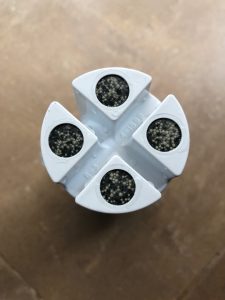The Brita filter package says it can save up to 1,800 water bottles per year. That is an interesting number when a filter only lasts for “40 gallons” or “about 2 months for the average family”. Does a Brita filter really last that long? I got thinking about this because we drink a lot of water in our house. Even when I did the “juice cleanse”, I needed a lot of water.
The top section of our filter pitcher has black spots after just two months. Is that carbon floating to the top or mold growing in the perfect environment of chorine free water? When I flipped over the Brita filter, I saw all of these white dots. What are those?
Not Recyclable?

The next thing I noticed is that the Brita filter isn’t recyclable. Those 1,800 bottles are. We use the Brita pitcher every day, and we also try and drink higher ph water when we buy bottled water. Those big mouth 9.5 ph bottles at Costco make for an easy refill so one bottle of alkaline water and one bottle of Brita Filtered water.
I got to thinking about this because the little replacement timer in the top of our pitcher died and the water tasted pretty bad yesterday. I guessed it was time to change the Brita filter. When I pulled the filter out to replace it, the bottom also looked like it had mold growing on it. The bottom four circles had about 80% coverage of white dots.
Has anyone ever tested the water quality of Brita water after 39 gallons have been filtered? Did that test occur after the Brita filter had been sitting on the counter or in the fridge for seven weeks? That is a water quality study I’d like to see. If you know of one please let us know so we can link it here.
The Study Findings:
I did find a study that said this:
Conclusion
Having briefly looked at some of the issues pertaining to water quality in both publicly supplied water and the private bottled water industry, how can the consumer best spend their water dollars? Based on the collected information about water quality and financial cost:
- it cannot be assumed that MWRA tap water quality is better than bottled water
- it cannot be assumed that bottled water quality is better than MWRA tap water
- the most economical way to acquire drinking water is from the tap
- boiling tap water is economical to disinfect microbial contamination and remove volatile contaminants, but does not remove all elements of concern
Therefore
- the most economical drinking water, with the greatest reduction of contaminants, is PWS tap water that has been filtered through an NSF certified filtration system
That study really doesn’t say that NSF certified filters are good to the last drop filtered. Trying to read the NSF certification list is pretty interesting too. The same companies have different filters that do different things. Zero, Pūr and Brita were names I recognized. Pūr is listed by its corporate name so it took some digging to figure out who they were.
It’s funny that scientists do all that work to test and identify what the filters do, then give us a list of every filter and what it claims to do. Why can’t they just list Best to Worst? Maybe that would put Consumer Reports out of business.
So for now I guess I’ll keep the in line filter for my ice maker and keep running the water through the Brita before making my morning green tea or after run water.
Editors Note: Since this was published we tested water in three different pitchers. When the water sat for a day or two things do start to grow in it. Our Medical Advisor says those minor biological growths are healthier than the metals, pesticides and other chemicals the filters remove. The Author has since upgraded to an under sink filter that also filters hormones and pharmaceuticals because he lives in Huntington Beach California – A toilets to taps city.